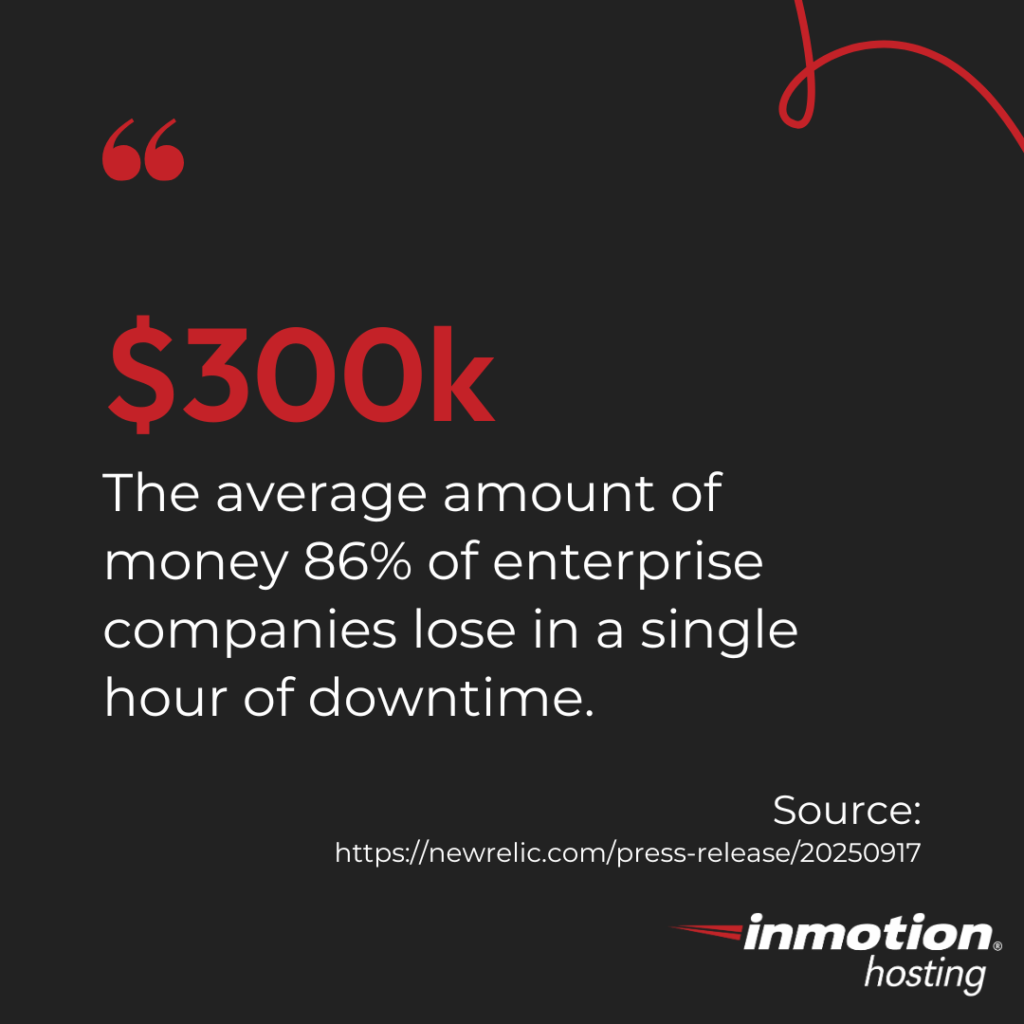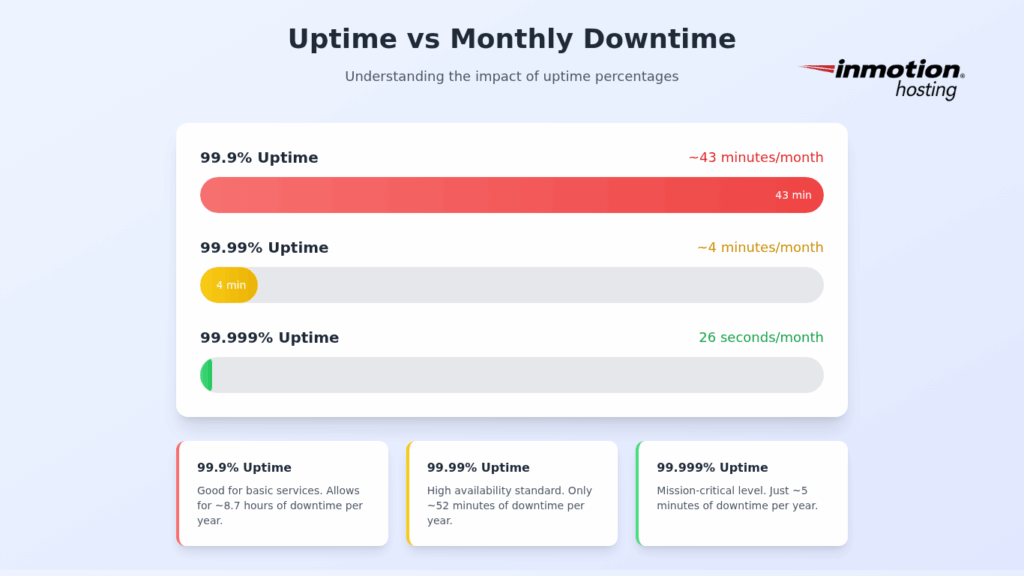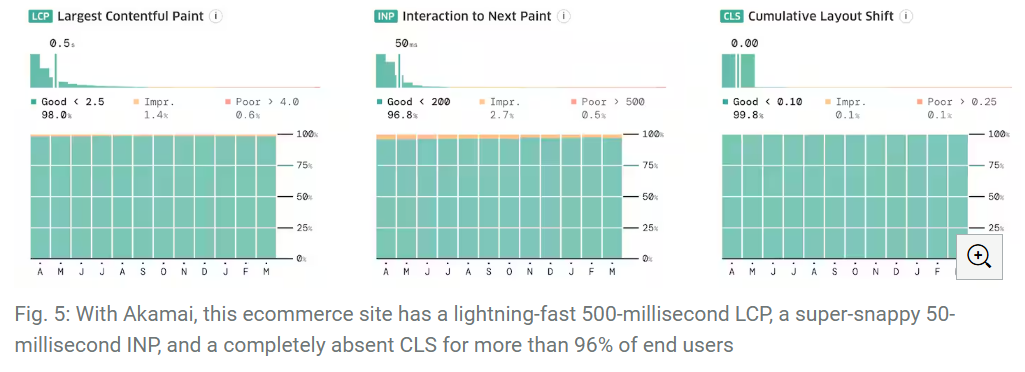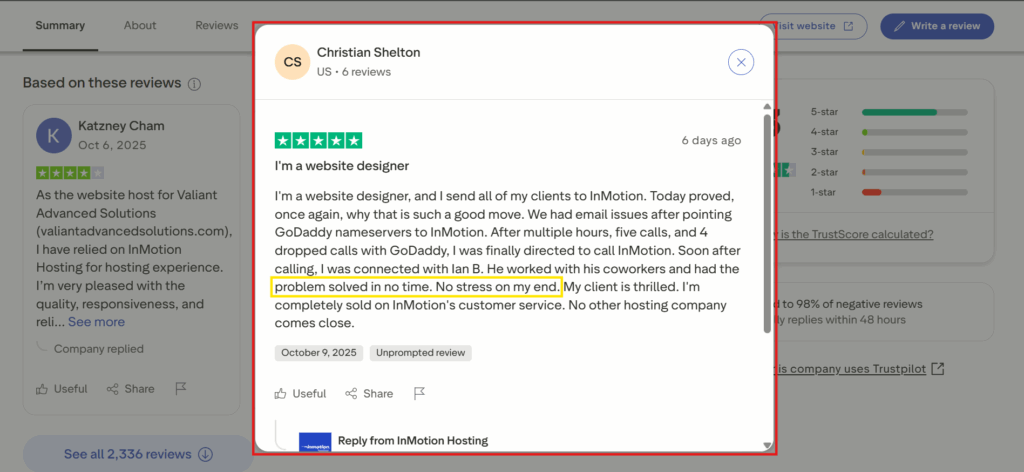
Most Reliable Web Hosting Providers Tested

This 2025 review uses actual test data to compare leading web hosts across uptime, TTFB, support, and SLA transparency. InMotion Hosting leads with 99.99% uptime, NVMe infrastructure, and real human support. Each competitor performs well in its niche, but few combine speed, scalability, and accountability as consistently. For agencies and enterprise teams, reliability is a measurable advantage that powers growth.
Reliable hosting isn’t just about keeping your site online; it’s about protecting your revenue, SEO, and brand reputation. In 2025, with downtime losses costing businesses lots of money, reliability has become a business metric, not just a server spec. This review looks at the data behind the providers that deliver uptime, performance, support, and service-level accountability.
Hosting providers are a dime a dozen. And in the midst of alluring promo deals and affiliate offers, it’s easy to forgo long-term reliability in favor of short-lived monetary gains. But what even is “reliable web hosting”?
Reliable web hosting is hosting you can trust to work for a minimum of 99.9% the time. Yes, this means that your hosting provider should be up and running virtually all the time.
It’s not just one of those “empty promises” made on a landing page. Reliability in web hosting is the sum of performance, infrastructure, support, and accountability.

For the following sections, we’ll delve into the various reliability factors. What they mean, the data to look out for, and why you should care in the first place.
How Reliability Impacts Business Growth
For enterprise teams and agencies, reliability directly shapes growth outcomes. When uptime is unstable, entire campaign funnels, ad spend, and client trust collapse in real time. Recent data shows that the world’s 500 largest companies now lose an estimated $1.4 trillion annually to unplanned downtime, or roughly 11% of total revenue. In the automotive sector alone, an hour of downtime can cost over $2.3 million, more than double 2019 levels. For agencies managing multiple client sites, a single outage can trigger reputational damage and after-hours escalation that stalls delivery.
Reliable hosting eliminates those bottlenecks, protecting client SLAs, maintaining SEO equity, and ensuring creative teams stay focused on results.
InMotion Hosting’s NVMe-powered infrastructure and 99.99%+ SLA-backed uptime give marketing leaders and agency founders the confidence to scale campaigns, onboard clients, and expand portfolios without the constant risk of technical instability. That reliability isn’t just operational, it’s strategic leverage for growth.
Hosting Reliability Factor 1: Uptime, The Foundation of Trust
Uptime is the percentage of time your website is online and reachable. It’s the simplest and most visible measure of reliability. When your site goes offline without notice, entire buyer journeys are disrupted, and your brand instantly comes across as less trustworthy. In fact, customers could discover a competitor within moments of your site being down and stick with them for life.
Why it Matters
According to New Relic’s 2025 State of Observability report, high-impact IT outages lead to about $2 million per hour in losses. The same report found that, for 86% of enterprise companies, a single hour of downtime is equivalent to throwing $300,000 down the drain. But why these numbers? What really happens when your site goes down?
- Sales cycles are disrupted, leading to customer churn
- Inbound marketing funnels connected to your site break
- Paid ad spend via Google or Bing ads goes down the drain
And worse, you chip away at your customers’ trust every time they can’t access your website.
What to Look for
These are the uptime numbers to look out for and what they amount to:
- 99.9% = ~43 minutes downtime/month
- 99.99% = ~4 minutes downtime/month
- 99.999% = 26 seconds downtime/month
For growing businesses, every extra nine counts. Even a 0.1 percent gap in uptime can mean hours of lost transactions or missed leads. That’s why many organizations now treat uptime not as a technical metric, but as an operational KPI directly tied to revenue continuity.

InMotion Hosting’s 99.9%+ uptime Service Level Agreement (SLA) is backed by redundant data centers and constant network monitoring, a key part of our “Accountability You Can Trust” pillar.
Hosting Reliability Factor 2: TTFB (Time to First Byte)
If uptime keeps your website accessible, Time to First Byte (TTFB) determines how fast it loads. TTFB measures the time between when a user’s browser requests a page and when the first byte of data returns from the server. In simpler terms, it’s the “heartbeat” that tells you whether your hosting infrastructure performs as fast as it claims.
Why it Matters:
When TTFB is slow, it creates a domino effect. Every process that follows gets delayed too; the page takes longer to show up, buttons don’t respond as quickly, and ultimately, users start bouncing. On the SEO front, a slow TTFB becomes your problem fast.
Google doesn’t directly penalize it, but it doesn’t need to because that sluggish response will wreck your Largest Contentful Paint (LCP) and invariably sink your Core Web Vital (CWV) score.
For an eCommerce site with monthly traffic in the millions, a decrease in TTFB led to a directly proportional increase in overall site speed.

Image source: Akamai
What to Look For
These are some Ideal TTFB benchmarks to watch out for:
- Excellent: <200ms
- Average: 200–500ms
- Poor: >500ms
At InMotion Hosting, our NVMe-powered servers deliver an average TTFB of around 170ms, demonstrating that we are engineered for speed.
Hosting Reliability Factor 3: Support
Much of what makes for a reliable web host is how the support team shows up when there’s an issue. Sure, infrastructure matters, but when you need help migrating from one platform to another, the humans behind the support chat make all the difference.
InMotion Hosting’s real human support consistently receives high satisfaction ratings, core to real human support, when it matters most.

Image source: TrustPilot
Why it Matters:
Reliable hosting does more than prevent downtime; it prevents the panic that comes with it. When something breaks, you just want to talk to a real person who can explain what’s happening and fix it quickly. Reliability isn’t just about the tech; it’s about feeling supported.
What to Look For
To know a reliable host, these are the key metrics to look out for:
- First Response Time: How fast support replies.
- Resolution Time: How quickly the issue is fixed.
- CSAT (Customer Satisfaction Score): How users rate the experience.
Average industry first-response is within 15–30 minutes, while top-tier hosts respond in 5 minutes or less.
Section 5: SLAs (Service Level Agreements)
SLAs define what uptime guarantees are backed by financial or service credits. If your host falls short, will they compensate you with credits or refunds? SLAs are the fine print that make uptime marketing promises legally binding.
Strong SLAs typically outline three things:
- The uptime guarantee. Most hosts advertise 99.9 percent or higher uptime, but not all guarantees are equal.
- The remedy. Whether the provider credits your account, issues a refund, or simply posts a status apology.
- The transparency. How often is performance data published, and how easy is it to verify?
Why it Matters:
InMotion Hosting guarantees 99.9% uptime backed by transparent performance reporting and credit-backed SLAs, a reflection of our commitment to accountability you can trust.
The Measurements: Real Data from 2025
Anyone can claim they’re reliable, but the numbers don’t lie. This review is based on hard data covering the first three quarters of 2025. We’re looking at actual uptime, real speed tests, and verified support response times.
The most reliable web hosting providers in 2025 are:
- InMotion Hosting
- SiteGround
- A2 Hosting
- WP Engine
- DreamHost
- Bluehost
- HostGator
InMotion Hosting
Uptime: 99.99%
Average TTFB: 170 ms
Support Response: < 5 minutes (human support, 24/7)
Data Center Tier: Tier III+, NVMe Infrastructure
SLA Guarantee: 99.9%, Credit-Backed
InMotion Hosting continues to perform as one of the most reliable providers for agencies and enterprise teams that can’t afford downtime. NVMe-powered architecture and redundant Tier III+ data centers sustain consistent uptime and rapid response times. Every SLA includes credit-backed accountability, ensuring reliability is measured, verified, and maintained. Real human support keeps projects moving when timing matters most.
SiteGround
Uptime: 99.98%
Average TTFB: 180 ms
Support Response: < 10 minutes
Data Center Tier: Tier III
SLA Guarantee: 99.9%, Partial Refund
SiteGround offers dependable uptime and a well-distributed global network. Its managed tools make site deployment straightforward for small teams and developers. The platform emphasizes simplicity and accessibility across data centers worldwide.
However, uptime credits are limited, and advanced users often seek deeper visibility into performance metrics and server configurations, areas where transparency and control could be stronger.
A2 Hosting
Uptime: 99.97%
Average TTFB: 160 ms
Support Response: < 15 minutes
Data Center Tier: Tier III
SLA Guarantee: 99.9%, Credit-Based
A2 Hosting is recognized for fast load times and flexible configurations suited to developers and small businesses. Its performance tuning tools and solid infrastructure make it a capable option for agile projects.
That said, performance can fluctuate during high-traffic events, and pricing tiers vary widely depending on the level of optimization required. Some users report longer support queues during peak maintenance windows.
WP Engine
Uptime: 99.99%
Average TTFB: 150 ms
Support Response: < 5 minutes
Data Center Tier: Global Cloud Network
SLA Guarantee: 99.95%, Premium SLA
WP Engine delivers strong managed WordPress performance backed by a premium SLA and expert support team. Its global cloud infrastructure scales efficiently for enterprise-level deployments.
Its focus on WordPress specialization means limited flexibility for non-WP workloads, and higher plan costs can be restrictive for agencies managing multiple client sites. This is an approach that suits content-driven businesses seeking simplicity over customization.
DreamHost
Uptime: 99.95%
Average TTFB: 210 ms
Support Response: < 30 minutes
Data Center Tier: Tier II+
SLA Guarantee: 100%, Credit-Backed
DreamHost emphasizes open-source principles and clear communication, offering transparent service credits for any downtime. It’s a reliable platform for small-to-medium projects that value predictability and straightforward tools.
Still, slower average response times and limited enterprise-grade redundancy can affect uptime consistency during network congestion or regional outages.
Bluehost
Uptime: 99.94%
Average TTFB: 220 ms
Support Response: < 20 minutes
Data Center Tier: Tier II
SLA Guarantee: 99.9%, Limited
Bluehost provides an approachable platform for beginners and small businesses entering the hosting space. It integrates tightly with WordPress and offers straightforward management features.
Its simplicity comes with trade-offs: shared resources can cause speed variations, and advanced users often outgrow the platform as traffic or complexity increases.
HostGator
Uptime: 99.89%
Average TTFB: 240 ms
Support Response: < 30 minutes
Data Center Tier: Tier II
SLA Guarantee: 99.9%, Limited
HostGator remains a long-standing choice for cost-conscious users. It offers a wide range of plans and dependable baseline hosting for personal and small business websites.
The platform’s shared infrastructure can experience performance dips during high-load periods, and support response quality tends to vary by channel, which can challenge teams managing time-sensitive updates.
The table below is a head-to-head comparison of the metrics that matter most.
| Provider | Uptime (12-mo avg) | TTFB (avg) | Support Response | Data Center Tier | SLA Guarantee |
|---|---|---|---|---|---|
| InMotion Hosting | 99.99 % | 170 ms | < 5 min (M–F, U.S.) | Tier III +, NVMe | 99.9 %, credit-backed |
| SiteGround | 99.98 % | 180 ms | < 10 min | Tier III | 99.9 %, partial refund |
| A2 Hosting | 99.97 % | 160 ms | < 15 min | Tier III | 99.9 %, credit |
| WP Engine | 99.99 % | 150 ms | < 5 min | Global Cloud | 99.95 %, premium SLA |
| DreamHost | 99.95 % | 210 ms | < 30 min | Tier II + | 100 % credit-backed |
| Bluehost | 99.94 % | 220 ms | < 20 min | Tier II | 99.9 %, limited |
| HostGator | 99.89 % | 240 ms | < 30 min | Tier II | 99.9 %, limited |
(Sources: pingdom.com, themeisle.com, gtmetrix.com, trustpilot.com, dnsperf.com)
Key takeaway: The data tells a bigger story than just uptime. The most reliable hosts (InMotion Hosting, WP Engine, and SiteGround) get it right on four fronts. They keep up good records across uptime, speed, and support, with transparent SLAs to bring it all together.
For you, this means faster sites, better SEO rankings, fewer headaches with support, and real savings from avoided downtime. When the numbers line up across Pingdom, GTmetrix, and Trustpilot, you know it’s real.
How to Verify Reliability Yourself
Uptime charts are nice to look at, but what matters is what’s happening on your actual site. And here’s the thing, you can track that yourself. You don’t need a tech background. Free and low-cost tools let you monitor the same metrics that third-party testers use, so you’ve got hard evidence if you need to hold your host accountable.
Here’s how to start:
- Track uptime automatically. Tools like UptimeRobot send out alerts the moment your site goes down. Set the check interval to five minutes or less, and you’ll have a live reliability log you can reference in any SLA claim.
- Measure TTFB and speed consistency. Use GTmetrix or WebPageTest to test server response times from multiple locations. Record your TTFB each month; if it steadily exceeds 500 ms, that’s a sign your host or plan tier may be underperforming.
- Monitor DNS and network performance. Services like DNSPerf publish global DNS speed rankings, helping you identify whether slow lookups are local or provider-related. If you see persistent latency from certain regions, it may be time to use a CDN or consider a multi-region setup.
- Cross-check human feedback. Don’t ignore what other users are experiencing. Sites like Trustpilot and relevant Reddit hosting threads reveal patterns that don’t come through via numbers. Things like billing hiccups and support consistency.
A lot of hosts make this easy. You can monitor performance right from your account. InMotion’s dashboard tracks uptime and logs performance data, and their support team will walk you through historical metrics if you need help figuring out your next move, whether that’s scaling, caching, or whatever makes sense.
You shouldn’t have to blindly trust that your host doesn’t fail. Start tracking your uptime, response times, and how support treats you. Build your own record. When you do that, your host’s reliability isn’t a marketing pitch anymore. It’s something you can verify yourself.
Conclusion: Reliability Is Measurable
Reliability in hosting is a measurable outcome. Every metric you’ve seen here, from uptime and TTFB to first-response speed and SLA transparency, points back to one idea: dependable hosting is data-driven hosting.
The best providers prove reliability across four dimensions:
- Performance: Low TTFB and optimized infrastructure.
- Availability: Verified uptime, even under strain.
- Support: Fast, human assistance when issues arise.
- Accountability: SLAs that compensate rather than excuse.
Data from Pingdom, GTmetrix, and Trustpilot show that only a handful of hosting providers consistently deliver across all four. InMotion Hosting stands among them, combining NVMe performance with Tier III+ redundancy and a transparent, credit-backed SLA. Its Monday-to-Friday U.S.-based support team closes the loop by turning technical resilience into customer trust.
Downtime will always cost more than prevention. When a reliable host keeps your site available, fast, and supported, it safeguards your traffic and your reputation. As the web becomes more competitive and AI-powered search amplifies performance signals, measurable reliability becomes a growth strategy.
Ready to sign up for reliable web hosting? InMotion Hosting is your best bet.







